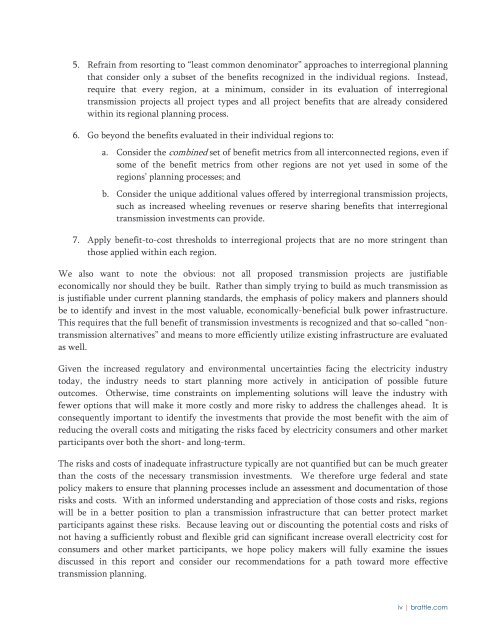THE BRATTLE GROUP
pvrbYG
pvrbYG
Create successful ePaper yourself
Turn your PDF publications into a flip-book with our unique Google optimized e-Paper software.
5. Refrain from resorting to “least common denominator” approaches to interregional planning<br />
that consider only a subset of the benefits recognized in the individual regions. Instead,<br />
require that every region, at a minimum, consider in its evaluation of interregional<br />
transmission projects all project types and all project benefits that are already considered<br />
within its regional planning process.<br />
6. Go beyond the benefits evaluated in their individual regions to:<br />
a. Consider the combined set of benefit metrics from all interconnected regions, even if<br />
some of the benefit metrics from other regions are not yet used in some of the<br />
regions’ planning processes; and<br />
b. Consider the unique additional values offered by interregional transmission projects,<br />
such as increased wheeling revenues or reserve sharing benefits that interregional<br />
transmission investments can provide.<br />
7. Apply benefit-to-cost thresholds to interregional projects that are no more stringent than<br />
those applied within each region.<br />
We also want to note the obvious: not all proposed transmission projects are justifiable<br />
economically nor should they be built. Rather than simply trying to build as much transmission as<br />
is justifiable under current planning standards, the emphasis of policy makers and planners should<br />
be to identify and invest in the most valuable, economically-beneficial bulk power infrastructure.<br />
This requires that the full benefit of transmission investments is recognized and that so-called “nontransmission<br />
alternatives” and means to more efficiently utilize existing infrastructure are evaluated<br />
as well.<br />
Given the increased regulatory and environmental uncertainties facing the electricity industry<br />
today, the industry needs to start planning more actively in anticipation of possible future<br />
outcomes. Otherwise, time constraints on implementing solutions will leave the industry with<br />
fewer options that will make it more costly and more risky to address the challenges ahead. It is<br />
consequently important to identify the investments that provide the most benefit with the aim of<br />
reducing the overall costs and mitigating the risks faced by electricity consumers and other market<br />
participants over both the short- and long-term.<br />
The risks and costs of inadequate infrastructure typically are not quantified but can be much greater<br />
than the costs of the necessary transmission investments. We therefore urge federal and state<br />
policy makers to ensure that planning processes include an assessment and documentation of those<br />
risks and costs. With an informed understanding and appreciation of those costs and risks, regions<br />
will be in a better position to plan a transmission infrastructure that can better protect market<br />
participants against these risks. Because leaving out or discounting the potential costs and risks of<br />
not having a sufficiently robust and flexible grid can significant increase overall electricity cost for<br />
consumers and other market participants, we hope policy makers will fully examine the issues<br />
discussed in this report and consider our recommendations for a path toward more effective<br />
transmission planning.<br />
iv | brattle.com


